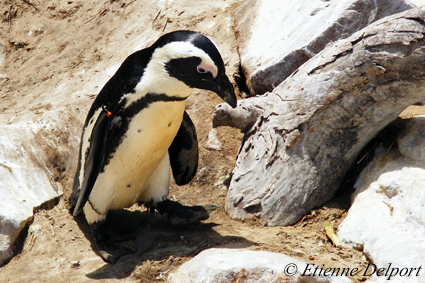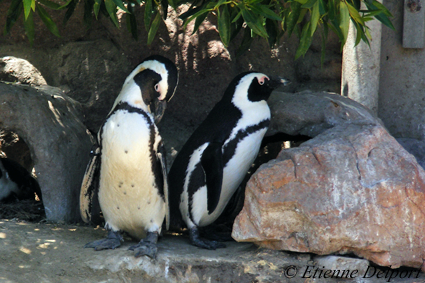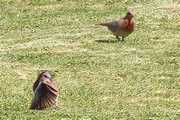Identification. The African Penguin (Spheniscus demersus)1, also known as the Black-footed Penguin or Jackass Penguin, grows to be about 60 to 70 cm in length and can weigh between 2.1 and 3.6 kg. They are black on top and white below with a black stripe and black spots on the chest. Their distinctive black and white colouring is a vital form of camouflage, white for underwater predators looking upwards and black for predators looking down onto the dark water. The black spots are unique for every penguin, somewhat like human fingerprints. Some birds may have a double black bar on the throat and chest which makes it virtually impossible to distinguish it from the Magellanic Penguin (Spheniscus magellanicus). They have pink glands above their eyes. The males are larger than the females and have larger beaks.
Juveniles are a dark greyish blue, lack the chest band and have grey cheeks.

Habitat. African Penguins normally occur within 50 km of the shore, mainly on the offshore islands. Infrequent visitors to the mainland except for the 3 breeding colonies.
Diet. African Penguins feed primarily on shoaling pelagic fish such as anchovies, pilchards (sardines), horse mackerel and round herrings. This diet is supplemented by squid and crustaceans. When on the hunt for prey African Penguins can reach a top speed of close to 20 km/h. The distance that African Penguins have to travel to find food varies. On the west coast a typical foraging trip could range from 30 to 70 km for a single trip. On the south coast foraging birds cover an average of 110 km per trip. When feeding their young the distance they can travel from the breeding colony is more limited. An average dive lasts about 2.5 minutes and is regularly about 30 m in depth. Dive depths of up to 130 m have been recorded. There are regional differences in diet and in some regions major changes in diet have followed human exploitation of their prey.
Call. African Penguins make a loud donkey-like braying sound. It is this sound which led to them being called Jackass Penguins. It can mostly be heard at the breeding grounds and at night. African Penguins are silent when at sea.
Breeding. African Penguins are monogamous, and the same pair will generally return to the same colony, and often the same nest site, each year. About 80 to 90% of pairs remain together in consecutive breeding seasons. Some pairs are known to have remained together for over 10 years. African Penguins normally lay 2 eggs and the incubation period is about 38 days. The male and female participate equally in the incubation duties. The length of the incubation shift is dependent on the availability of food at the time but is typically about 2.5 days. After hatching the chicks are fed for about 80 days before they start foraging for themselves.

South African Distribution. African Penguins are endemic to southern Africa, occurring along the coast from northern Namibia to Port Elizabeth. They mainly frequent the 24 islands along the coast but there are 3 mainland breeding colonies.
Port Elizabeth Area. If you are lucky you may find African Penguins at Cape Recife Nature Reserve or else you may utilize an organized tour to the breeding islands in Algoa Bay. African Penguins may be viewed in captivity at Bayworld or at the South African Marine Rehabilitation Centre, SAMREC, at Cape Recife.
Conservation Status – EN (Endangered)2 This species has been uplifted to Endangered because recent data has revealed that it is undergoing a very rapid population decline, probably as a result of commercial fisheries and shifts in prey populations. This trend currently shows no sign of reversing and immediate conservation action is required to prevent further declines.
- African Penguin entry on Wikipedia ▲
- IUCN Redlist – African Penguin Fact Sheet ▲


